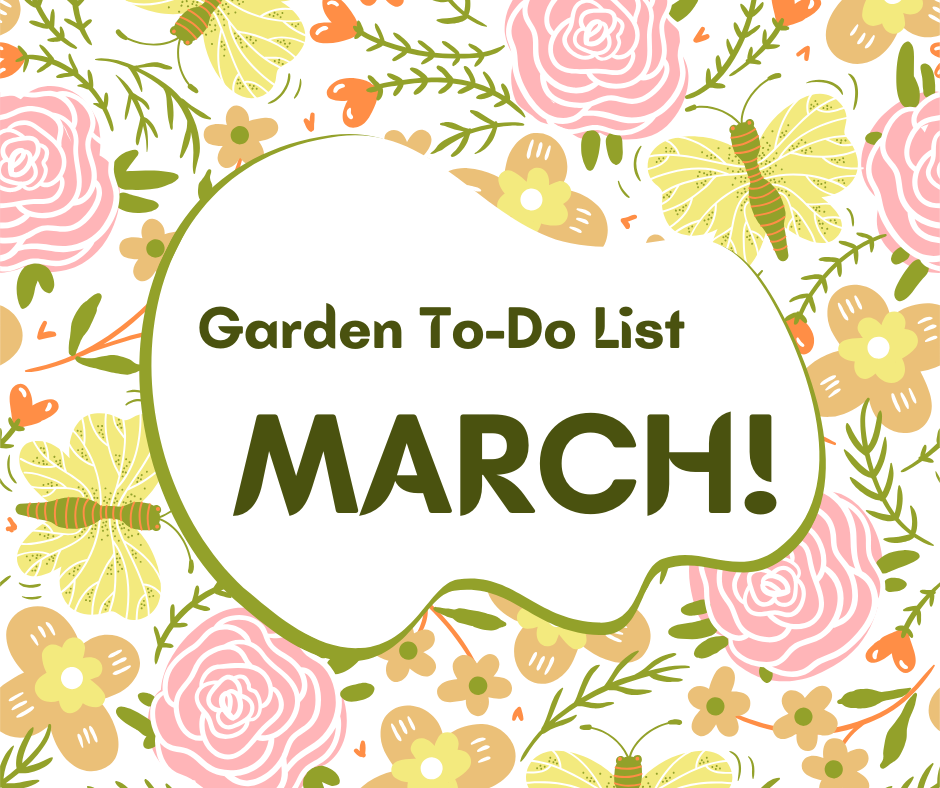Garden to-Do List March
go.ncsu.edu/readext?1059881
en Español / em Português
El inglés es el idioma de control de esta página. En la medida en que haya algún conflicto entre la traducción al inglés y la traducción, el inglés prevalece.
Al hacer clic en el enlace de traducción se activa un servicio de traducción gratuito para convertir la página al español. Al igual que con cualquier traducción por Internet, la conversión no es sensible al contexto y puede que no traduzca el texto en su significado original. NC State Extension no garantiza la exactitud del texto traducido. Por favor, tenga en cuenta que algunas aplicaciones y/o servicios pueden no funcionar como se espera cuando se traducen.
Português
Inglês é o idioma de controle desta página. Na medida que haja algum conflito entre o texto original em Inglês e a tradução, o Inglês prevalece.
Ao clicar no link de tradução, um serviço gratuito de tradução será ativado para converter a página para o Português. Como em qualquer tradução pela internet, a conversão não é sensivel ao contexto e pode não ocorrer a tradução para o significado orginal. O serviço de Extensão da Carolina do Norte (NC State Extension) não garante a exatidão do texto traduzido. Por favor, observe que algumas funções ou serviços podem não funcionar como esperado após a tradução.
English
English is the controlling language of this page. To the extent there is any conflict between the English text and the translation, English controls.
Clicking on the translation link activates a free translation service to convert the page to Spanish. As with any Internet translation, the conversion is not context-sensitive and may not translate the text to its original meaning. NC State Extension does not guarantee the accuracy of the translated text. Please note that some applications and/or services may not function as expected when translated.
Collapse ▲by Eleanor Moyer, Extension Master Gardener℠ Clay County Volunteer
- Reseed or resod lawns through mid-month.
- Begin pre-emergent weed control on lawns and in flower beds. However,
consider that flowering weeds provide food for important pollinators. - Mulching is an earth friendly alternative in flower beds.
- Clean up perennials, removing dead leaves. Waiting until now has saved
many overwintering beneficial insects. - Spray new growth on bearded iris with imadacloprid to control borers
through early April. - Apply dormant oil spray to fruit trees and ornamentals to control
overwintering insects. - Certainly pick those lovely daffodils, but leave foliage intact.
- Freshly cut daffodils produce a chemical that injures other flowers in a
mixed arrangement. Isolate them in water for a day, then rinse the stems
before mixing with other flowers. - Fertilize spring bulbs as flowers fade.
- Prune floribunda, grandiflora, and hybrid tea roses. Remove dead,
crossing and inward facing stems. Begin fertilizing as buds break.
Plant bare-root roses now. - Do not prune forsythia, quince, and other spring blooming shrubs until
AFTER flowering. - Continue planting snow peas, garden peas and kale. Irish potatoes,
cabbage, broccoli and cauliflower transplants can be put out at the end of
the month. - Floating row covers will protect against insects and light frosts.
- Remove mulch from strawberry beds when flower buds appear.
- Warm season vegetables (eggplant, tomato, peppers) can still be started
indoors from seed. - Divide and transplant summer perennials and ornamental grasses as new
growth begins. - Prune evergreen shrubs back to a manageable size before new growth
begins. - Get your soil tested. The County Extension Agency has soil test boxes and instructions.




